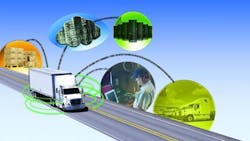Trucking is no stranger to the uses of telematics technology. Indeed, many fleets are leading the way in terms of how to increase benefits from such systems.
Yet it’s also important to remember that the telematics needs of the trucking industry are very different from what’s being delivered in the broader automotive market, particularly when it comes to tapping telematics data for maintenance purposes.
Fleet Owner got a chance to talk about trends in trucking telematics with Toby Weir-Jones, head of the fleet division at CalAmp; a company that acquired tracking solutions provider LoJack Corp. back in March of this year.
First, when you look at the trucking telematics market, how does it differ from ‘consumer’ telematics found in automobiles? How are the needs different?
There are a few important differences; some are more obvious than others. First, the use cases and data gathering are different. A trucking user is more concerned with things like road taxes, hours of service (HOS), vehicle utilization, fuel costs, and machine health.
For an owner-operator, those factors translate directly to the personal bottom line. For a fleet, there are various compliance and liability issues, which are managed as an overall corporate risk posture. Yet both are acutely aware of the costs of unscheduled downtime, particularly when expensive repairs are required in the middle of a job.
The next difference is around the equipment itself. Consumer equipment, installed in light-duty trucks and passenger cars, has to be smaller, and may have to plug into an OBD2 [onboard diagnostics] connector. Those vehicles are typically “softly sprung” and ride gently, as well as accumulate fewer miles.
A trucking user, however, needs a heavy duty interface and needs to plug it into a J1939 JBUS connector. Some commercial users want a hardened, tamper-proof device with a backup battery to detect attempts to disconnect its main power supply. Trailers are often unpowered and need a device with a long-life built-in service battery.
Finally, the data requirements are different. Trucking telematics are more likely to need a router capability so that other applications can tunnel data back to headquarters over a shared data plan. They need to collect engine health data off JBUS parameters, and they have to work when crossing borders or in remote areas where signal strength is marginal and higher-gain antennas may be required.
There’s also a need to watch the data costs as an overhead expense, minimizing them wherever possible, because the trucks are active for so many hours and miles.
What do you think will be the “next big thing” in the trucking telematics space?
For trucking in particular – and heavy equipment in general – the next big thing we see coming centers on contextual utilization. The classic “use case” of sticking to a rigid schedule for service events is an indirect expense because there may be conditions under which the risk of not performing maintenance sooner than those prescribed intervals may be too large to ignore. To make that an informed decision, however, requires a lot more than the classic “dots on a map” telematics feeds.
Next is the cost of connected services. Cost is only the driving factor among suppliers who otherwise have no differentiators to offer. We are working hard to keep bringing more and more connected vehicle parameters into the data we provide. This will lead to new reports and behaviors within our hosted applications, and it can expand the data integration options we support for connecting our systems to back-end enterprise applications our customers may already be using.
Information is the value proposition for the customer and we can always bring more value into the solution once the hardware footprint is in place.
Are there any trucking segments that are “underserved” or “overlooked” by the telematics revolution going on in trucking?
We think the market is still overly focused on a basic question: “Where are you now?” There are lots of great presentations of that information but it’s largely a commodity solution at this point.
The growth into the owner-operator segment continues and is certainly being driven by the overall connected lifestyle many of them have adopted. But they also have expectations of a more consumer-type user experience. They want to use familiar interfaces on in-cab terminals, they want to set aside concerns about whether they’ll blow their data budget for the month, and they want the tap-and-swipe user interface.
We’re also seeing is a move away from proprietary, closed ecosystems, which are the traditional purview of enterprise environments. Software design and ease of use are likely to make the difference between eyeballs on the app or not, and it’s dangerous to assume you’ll always be able to service every customer’s requirements within your own applications. So integration to third party systems will be key, even if the driver in the seat doesn’t know a thing about APIs [application program interfaces] and ERP [enterprise resource planning].
It just has to work after little or no setup complexity, and it’s incumbent upon industry to deliver those solutions.
Talk about how cargo security and telematics intersect. LoJack, which CalAmp acquired back in Mach, made its name helping retrieve stolen autos via telematics and transponders. Does cargo theft prevention require a different approach?
Cargo theft prevention falls into two categories. The classic LoJack approach is to watch the whole truck or machine. It’s either where you expect it to be, or it isn’t, in which case you report it stolen.
We also offer the CalAmp/LoJack Supply Chain Integrity solution, which allows us to track individual shipments on every step of their journey using telematics tools.
We use small, battery-powered devices which are embedded into an individual package and can report their location and other parameters whether they’re in the back of a truck or waiting in a warehouse.
The difference is that the general approach is reactive in the classic LoJack model — you alert police when something bad has happened — and proactive in the telematics model. It’s in the second case you can take action if you see a deviation from the expected path, even if it’s not clear why just yet.
Finally, what advantages does CalAmp/LoJack bring to the trucking telematics table?
The main advantages for CalAmp/LoJack fall into two categories: depth of platform knowledge and breadth of use case solutions.
Platform knowledge is one of those things many customers may not think about until they have a poor experience with someone who is white-labeling another solution and unable to dive into the root cause of a problem. It’s the reason fuel purchase networks are attractive. The benefits of centralized reporting and predictable costs, as well as some incentives along the way, are what the driver sees even though the guts behind the scenes to make it all work are elaborate, expensive, and a product of decades of work.
We know how hard it is to make all these tools work properly and accommodate so many different customer needs, and we’re always on point to expand that scope based on existing and anticipated evolutionary shifts.
The breadth of use cases is apparent when you look at our platform tools, our hosted applications, and our range of hardware offerings. Not everybody wants the same emphasis in their user interface. For some customers, they want to pull data into their own application and make that available to customers downstream. For them, our platform tools are the best available option. Other customers want to login to a CalAmp web application and run their business that way because they’re not developers and recognize our range of features are able to offer them solutions quickly and inexpensively.
On the hardware side, mixed fleets of on- and off-road equipment, unpowered assets, and even individual high-value shipments all need different device solutions. Note that we have over 5 million devices under active management on our platforms and are currently adding to that at a rate of roughly 1.5 million devices annually.
While some of those devices must be environmentally sealed and tamper-resistant, others must be adaptable to a wide range of specialty plug-and-play interfaces. Still others need to work in remote locations, or internationally, or only when certain trigger conditions are present.
We offer dozens of hardware solutions and can customize their behavior further via our infrastructure tools, such as PEG and PULS, all the while making feeds available on the CalAmp Telematics Cloud.
In the end it is all about leveraging its experience with large-scale telematics deployments to bring new connected vehicle solutions to market.
About the Author
Sean Kilcarr
Editor in Chief
Sean Kilcarr is a former longtime FleetOwner senior editor who wrote for the publication from 2000 to 2018. He served as editor-in-chief from 2017 to 2018.

